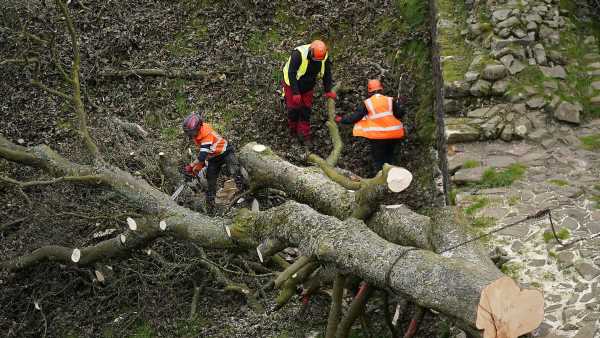Sycamore Gap tree is cut up before it is removed by crane from Hadrian’s Wall and held in storage after 300-year-old tree was felled by vandals – as stump is left to grow new saplings
The Sycamore Gap tree has been cut up ahead of it being moved from the site of Hadrian’s Wall after it was felled in an act of vandalism last month, the National Trust has confirmed.
The sycamore, which stood in a dip alongside the wall in Northumberland for 300 years, had been one of the world’s most photographed trees until it was chopped down overnight on September 27.
The destruction of the iconic tree, which was famously featured in Kevin Costner’s 1991 film Robin Hood: Prince of Thieves, has so far led to two arrests – former lumberjack Walter Renwick, 69, and a 16-year-old boy – both of whom have been released on bail.
It has now been revealed a crane will be used to lift the 50ft tree off the historic and delicate Roman wall, before it is removed from the area and put into safe storage at a trust site.
As it was too big to move in one piece, experts claimed there was no other option but to cut it up however they hope to keep the trunk in large sections to keep options open on what could be done with it in the future.
The Sycamore Gap tree has been cut up ahead of it being moved from the site of Hadrian’s Wall
The sycamore, which stood in a dip along Hadrian’s Wall in Northumberland for 300 years, was one of the world’s most photographed trees – but it has now been reduced to a stump
It has now been revealed a crane will be used to lift the 50ft tree off the historic and delicate Roman wall
Work begins in the removal of the felled Sycamore Gap tree in Northumberland
Seeds have been collected from the tree which the National Trust said could be used to propagate new saplings
The stump, which could generate new shoots, will be kept in place and is currently behind a protective barrier.
Seeds have been collected which the National Trust said could be used to propagate new saplings.
The much-photographed and painted lone sycamore, said to be one of the most famous trees in the world and an emblem for the North East of England, was situated in a dramatic dip in the Northumberland landscape.
Northumbria Police arrested a boy aged 16 and a man in his 60s after the tree was felled a fortnight ago. They have been released on bail pending further inquiries.
Since then, the National Trust has received thousands of messages about the tree, with advice on what to do with the stump and suggestions of what could be done with the felled tree.
Andrew Poad, the site’s general manager for the National Trust, said: ‘We’ve been amazed and inspired by the offers of help and good wishes we’ve received from here in Northumberland, around the UK, and even from overseas.
‘It’s clear that this tree captured the imaginations of so many people who visited, and that it held a special – and often poignant – place in many people’s hearts.’
The National Trust has received thousands of messages about the tree, with advice on what to do with the stump
Experts say a section of Hadrian’s Wall was damaged when the colossal tree fell on it
The stump, which could generate new shoots, will be kept in place and is currently behind a protective barrier
The site will be prepared on Wednesday before the tree is removed on Thursday, with people being urged to stay away from the immediate area when it happens.
READ MORE: How the Sycamore Gap Tree could rise again: Scientists claim they have the technology to grow an IDENTICAL copy of the felled tree at Hadrian’s Wall
Mr Poad said: ‘It’s currently in a precarious position resting on the wall, so it’s necessary we move it now, both to preserve the world-famous monument that is Hadrian’s Wall, and to make the site safe again for visitors.
‘We’ve explored every option for moving the tree and while it isn’t possible to lift it in one go, as the tree is multi-stemmed with a large crown, we have aimed to keep the trunk in as large sections as possible, to give us flexibility on what the tree becomes in future.
‘We’re encouraging people to stay away from the site while these complex and difficult operations take place.’
There will be public consultation about what happens next at the site, which has Unesco designation and is a Scheduled Ancient Monument.
Mike Innerdale, the National Trust’s regional director for the North of England, said: ‘The outpouring we’ve seen shows just how important the connection is between people and nature in its many forms, and as we consider plans for this special tree, and this very special place, we’ll also look to harness that support for trees, landscapes and nature all across the country, and use the sycamore as a symbol of recovery.’
The preservation body Historic England said Hadrian’s Wall sustained damage when the tree fell on it.
Forensic scientists had previously revealed tiny traces of oil left on the stump of the Sycamore Gap tree could help police in their hunt for the person who chopped it down.
The experts are reportedly searching tree samples for traces from the chainsaw’s oiler, which may have left a chemical ‘fingerprint’.
Tiny traces of oil left on the stump of the Sycamore Gap tree could help police track down the person responsible for felling it, forensic scientists have revealed
Floral tributes have been left on the stump after the tree was felled in an act of vandalism, police said
In the latest twist to the Sycamore Gap mystery, it has been reported that forensic scientists are searching tree samples for traces from the chainsaw’s oiler, which may have left a chemical ‘fingerprint’
The oil lubricates the chain to stop it from overheating and seizing up. And forensic experts have shed new light on how a unique blend of oil could help uncover the saw used to cut down the tree.
READ MORE: Vandals who felled the Sycamore Gap tree damaged Hadrian’s Wall, investigators say
Dr Angela Gallop, one of the UK’s most experienced forensic scientists who helped to convict two of Stephen Lawrence’s killers, told The Times that traces of oil left on the stump from the chainsaw could help with finding the saw which was used.
She added: ‘When topping up machinery with different types of oils, you might add one type of oil with another type of oil with slightly different chemical components, and build up a chemical ‘fingerprint’.’
Another source told the newspaper that farmers often try and save money by using engine oil to lubricate the chain. They added it was possible that the feller could have used a popular brand such as Husqvarna or Stihl.
‘Or perhaps a blend of both might be found, giving a unique forensic makeup,’ they added.
Amid the outcry from locals, politicians and environmentalists, detectives are looking at charges for felling the tree without consent, while it emerged earlier this week that they are probing some damage caused to Hadrian’s Wall – a heritage site – which could bring harsher sentences.
The investigation has been hampered by a lack of CCTV and witnesses as it was carried out in the remote area in the night. This is why Northumbria Police is hoping to find answers though forensic expertise, despite lack of research in the area for trees.
Officers hope that sawdust and tree particles will have been left on the feller’s tools or clothing which could be linked back to the tree. Pictured: Forensic officers examine the tree
The Sycamore Gap tree on Hadrian’s Wall is seen on the ground after it was felled last month
Officers hope that sawdust and tree particles will have been left on the feller’s tools or clothing which could be linked back to the tree.
It comes after bailed former lumberjack Walter Renwick declared his innocence as he returned home to a farm where police found a large chainsaw.
Mr Renwick, who was due to be evicted the day the felled tree was found, was seen back at Plankey Mill Farm last week after being taken into custody, with pictures and video showing him standing topless outside a caravan on the property.
Officers spent three days scouring an adjoining property that Walter Renwick was evicted from last week.
And minutes before the former lumberjack turned up they confiscated a 3ft chainsaw and other possible evidence.
He was bailed on Sunday afternoon and was driven back to his campervan where he declared his innocence, shouting: ‘I know I’m f****** innocent, right, and that’s all I need to know.’
Mr Renwick has vehemently denied being responsible for the downing of the 300-year-old tree and seemingly said the saw was proof that he was completely innocent.
Despite the outcry that followed the tree’s felling, experts believe that it is from down and out and the stump is very much alive.
The tree was made famous in Kevin Costner’s 1991 film Robin Hood: Prince Of Thieves
Over the decades the iconic view has become the backdrop for countless marriage proposals
Jo Clark, Head of Research at non-profit The Future Trees Trust, told MailOnline: ‘Broad-leaf trees such as sycamore, ash, oak, hazel, chestnut readily grow back from a cut stump, especially when young.’
When a tree is cut back to a stump and survives, it can coppice, resulting in a number of thin trunks will growing from the base rather than a single large trunk.
Mr Clark says that it is ‘highly possible’ that the Sycamore Gap Tree will coppice, provided the regrowth can be protected from the local deer population which might otherwise eat it.
However, even if the tree does survive in this way, it will never regrow into the same stately form that inspired tourists and film makers alike.
Earlier this week, it emerged that a 1,000-year-old tree which dates back to the Battle of Hastings was mysteriously uprooted in a ‘suspected felling’ – just a week after Sycamore Gap Tree was cut down.
The 40ft yew tree stood in a privately owned field near Uckham Lane, Battle, a mile from Senlac Hill.
Speculation has mounted about how it had been toppled, with some suggesting the tree was deliberately cut down while others say it could have been knocked over by recent strong winds.
Source: Read Full Article














